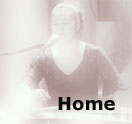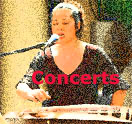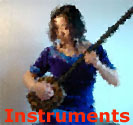





 |
 |
 |
 |
 |
 |
Xu Fengxia plays the Guzheng and the Sanxian
 |
|
Guzheng - played by Xu Fengxia Xu Fengxia`s guzheng has 21 strings. Their pitch is defined by the position of the bridges.(the wooden triangle things in the middle). The "Zheng" was already in use during the "spring and autumn" period (about 700 b.c.) mentioned in documents from the area of Qingdi (now Sha´anxi province). During Han- dynasty(from 206 b.c.) this instrument became very popular througout China. It was played by the famous poet Liu Xi. In those days the strings were very thin and had - compared to now- a quite high pitch. There were more additional strings included-from 12 to the modern guzheng with 21 to 25 strings. The guzheng is made out of the wood of an asian type of plane-tree. The bridges are called "Yan Zhu", which means "Feet of wild geese". Because it is possible to change the position of the bridges this instrument can be played in any scale or key- from traditional Chinese pentatonic keys to western minor and major keys or new composed scales in contemporary music. The guzheng usually is plucked but Xu Fengxia also uses violin bows or makes percussive sounds-with her hand or various sticks. Xu Fengxia plays classical Chinese music from the court, adaptations of songs and dances from the many provinces and peoples of China, compositions of contemporary Chinese composers, own compositions and improvisations. |
|
|
|